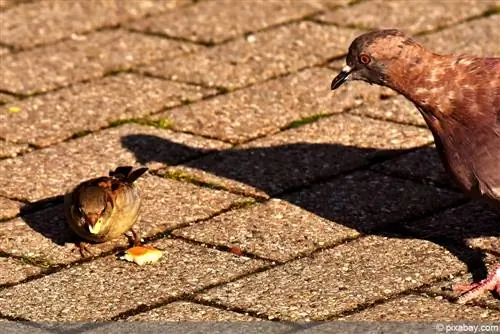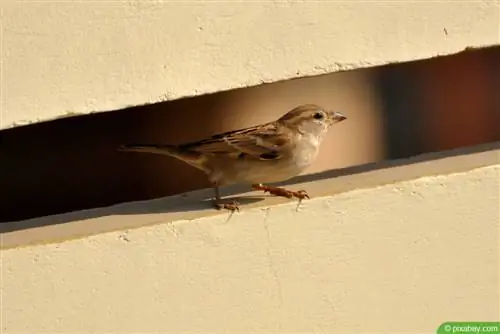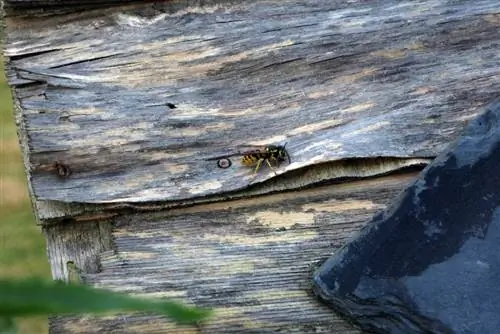- Author admin [email protected].
- Public 2023-12-17 03:39.
- Last modified 2025-01-24 12:45.
Over time, certain birds have become accustomed to being around people and settle under the roof. However, due to the background noise and droppings, the animals can quickly become a nuisance.
Build dummy birds
Depending on the architecture of the building, the roof and the facade of the house can provide inviting nesting places for certain species of birds that feel safe there. These primarily include titmice, swallows, sparrows, woodpeckers and pigeons. However, the excreted bird droppings can become a burden after just a short time. As a result, clearly visible damage to the building structure occurs. In addition, the constant chirping can soon get on the residents' nerves, especially if someone works from home in the home office. Therefore, adequate measures must be taken promptly to drive the birds away. Otherwise it can happen that the animal tenants become a real nuisance. Since the bird species mentioned have natural enemies in the form of various birds of prey, erecting threatening bird dummies near the roof tiles has proven useful. The smaller bird species instinctively flee and avoid close contact with the dummies.
- Magpies, crows and ravens are dangerous predators
- Attach dummy birds in their shape to the house and in the garden
- Imitate the contours of birds of prey in black color
- Templates can be purchased at gardening stores
- Your own production is also possible
- Change the location of the bird dummies regularly
- Otherwise you will soon get used to it
Tip:
Our ancestors long ago placed frightening scarecrows on the property to effectively drive away unwanted bird species.
Construction measures
In order to prevent birds from settling on the roof, certain structural measures can be taken. If the landing is uncomfortable for the animals, they quickly run away. It is also important to have protective covers for open areas on the roof, for example the exhaust shafts, which are otherwise well suited for nesting. As soon as all possible places are covered with wire mesh, even small bird species can no longer build nests there.
- Constructing roofs without shelter and protection
- Covering roof tiles with flat and smooth surfaces
- Make it completely impossible as a landing site
- Line roof ledges with wooden boards
- Set up boards with angles over 45 degrees
Wind chimes as a repellent
Most species of birds are also frightened by reflective surfaces and objects that are very dazzling in sunlight. Homemade wind chimes can be hung almost anywhere on the property and near the roof tiles. With a little craftsmanship experience, you can quickly make various types of hangers. Thanks to the deterrent effect, the majority of animals prefer to look for a new home. However, it can happen that particularly cheeky creatures get used to the reflective hangers after a while. Therefore, the locations of the devices must be changed periodically in order to maintain the defensive effect.

- Wind chimes can be created with old CDs
- Alternatively use old mirror pieces
- Tie reflective parts together with strong string
- Attach at different heights
- Make sure it is wind and weatherproof
- Attach to various locations in the house and garden
Wire as defense
Since numerous bird species are protected in Europe and some of them are even in acute danger of extinction, there are legal regulations regarding their removal. Bird nests must never be removed during the breeding season and the young birds must always be left alone. It is therefore better to prevent the animals from settling there from the start. In this context, the combination of wire tips with dummy birds has proven effective in defense. This effectively prevents unwanted bird species from landing on the roof tiles and making their home there.
- Attach wire as defense spikes on roofs
- Available as longer strips in stores
- Prevent entry by feathered animals
- Attach stainless steel variants to the gutter
- Arrange on the roof overhang and nearby walls
Get rid of noises
Basically, birds are rather shy animals that can easily be frightened and driven away. This works very well with loud noises and other sounds. These repellents comply with the law and are absolutely harmless to the animals. In addition, certain devices also produce very pleasant sounds, which create a harmonious ambience for the residents. In the long term, the resulting noise confuses and scares away most bird species.
- Install sound hangers near the roof tiles
- Chimes and sounding wooden mobiles are also effective
- Alternatively install wind chimes made of flags
- Rattling wind turbines are also suitable
- Have a deterrent effect due to movement in the wind
- Place in busy places
Note:
When it comes to wind chimes, it is not the size of the system that is important, but rather the targeted placement in the places frequently visited by the animals.
Remove holes
Vacities, holes and wall openings under the roof overhang are very popular for nest building. Because these areas are at a high altitude, they are difficult to access for residents and are therefore relatively safe. Woodpeckers and swallows are known to enlarge these openings even further in order to make their home there. However, the penetrating moisture can affect the thermal insulation of the building and lead to long-term damage. If you want to avoid new settlement or get rid of returning migratory birds, you should eliminate these inviting cavities on the house facade.
- Check the house facade regularly for any holes
- Fill cavities as quickly as possible
- Perform by February at the latest
- The first migratory birds return at the beginning of spring
- It's better to check in autumn to avoid damage
Pets to Deter
If you have pets, they can help you get rid of the birds. Both dogs and cats love to hunt feathered animals. In this way, the chirping pests can be quickly driven away when they are looking for food sources on the property. In general, the very presence of these pets acts as a deterrent for many bird species.

- Let the dog out more, barking is intimidating
- Free-roaming cat also serves as bird deterrent
- Try to reach the flying visitors under the roof
- Meowing and attempted attacks are often enough to get rid of them






